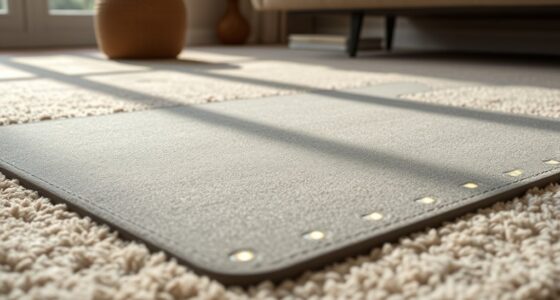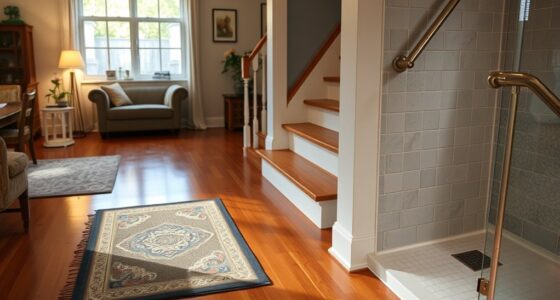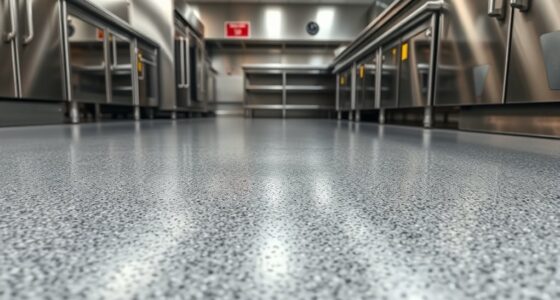Hidden hazards in your home, like hidden fires from faulty wiring, mold in damp areas, and electrical overloads, can threaten your safety and health without obvious signs. Regularly check smoke detectors, keep areas dry and ventilated, fix leaks promptly, and avoid overloading circuits. Staying vigilant and conducting routine inspections helps catch these dangers early. Keep exploring to discover simple steps that can make your home safer today.
Key Takeaways
- Regularly inspect and test smoke detectors, fire extinguishers, and electrical systems to prevent fire hazards.
- Keep damp areas like bathrooms and basements dry, ventilated, and promptly fix leaks to prevent mold growth.
- Conduct routine home inspections to identify hidden issues such as pests, lead paint, or structural problems early.
- Address signs of mold, moisture, or pests immediately with proper cleaning and professional assistance if needed.
- Maintain safety features like locks, alarms, and proper ventilation to protect household members from unseen dangers.

Many hazards in your home often go unnoticed, quietly posing risks to your health and safety. One of the most critical areas to focus on is fire safety. Fires can start unexpectedly from everyday sources like unattended cooking, faulty wiring, or overloaded outlets. To prevent this, you need to regularly check your electrical systems and avoid overloading circuits. Keep a fire extinguisher accessible in key areas such as the kitchen and garage, and ensure everyone in your household knows how to use it. Installing smoke detectors on every floor and testing them monthly can give you early warning and help you respond quickly if a fire does break out. Remember, a small fire can escalate rapidly, so staying proactive with fire safety measures is essential.
Another often overlooked hazard is mold, which can develop in places you might not frequently inspect. Mold not only damages your home but also poses serious health risks, especially for allergy sufferers or those with respiratory issues. Mold thrives in damp, poorly ventilated areas like bathrooms, basements, and around leaky pipes. To prevent mold growth, keep these areas dry and well-ventilated. Use exhaust fans in the kitchen and bathroom, and fix any leaks promptly before moisture has a chance to settle in. Regularly clean surfaces prone to moisture buildup with mold-inhibiting solutions, and consider using a dehumidifier in areas with high humidity. If you notice a musty smell or visible mold, address it immediately. Wearing protective gear and using proper cleaning agents can help eliminate mold safely. If the problem is extensive, hiring a professional mold remediation team is the safest route to ensure your home remains healthy.
Beyond fire safety and mold prevention, be mindful of other hidden hazards like lead-based paints in older homes or hidden pests that can carry diseases. Regular home inspections can help you catch these issues early. Keep an eye on water quality, and ensure your home’s ventilation is adequate to prevent moisture buildup. Additionally, understanding home safety features, such as secure locks and smoke alarms, can further protect your household. By taking these simple but crucial steps, you can greatly reduce the risk of accidents and health problems lurking behind your walls. The key is staying vigilant and proactive—you don’t have to wait for a crisis to take action. Addressing these hazards now not only protects your loved ones but also preserves your home’s integrity. Remember, many dangers are invisible or silent, so make it a habit to routinely assess and improve your home’s safety measures. Your health and safety depend on it.
Frequently Asked Questions
How Often Should I Inspect My Home for Hazards?
You should perform a home inspection for hazards at least once every three to six months. Regular hazard awareness helps you catch issues early, preventing accidents or damage. Keep an eye out for signs of wear, leaks, or electrical problems. By staying vigilant and conducting routine inspections, you guarantee your home remains safe and well-maintained. Don’t wait—make hazard awareness a regular part of your home care routine.
Are There Affordable Ways to Improve Home Safety?
Like a trusty smartphone, your home needs regular checkups. You can find affordable ways to boost safety with simple DIY upgrades—think installing grab bars or sealing cords. Conduct a budget assessment to prioritize fixes, and look for DIY solutions that save money. Small changes make a big difference, so don’t wait for a crisis—invest time and effort now to keep your home safe without breaking the bank.
What Signs Indicate Hidden Mold or Asbestos?
You should look for signs like musty odors, discolored walls, or peeling paint, which could indicate hidden mold growth. For asbestos exposure, watch for crumbling or damaged insulation, ceiling tiles, or flooring materials that may contain asbestos. If you notice these signs, it’s vital to get a professional inspection. Addressing mold and asbestos hazards early helps protect your health and prevents costly repairs later.
How Can I Child-Proof My Entire House Effectively?
Did you know that falls are the leading cause of injury among children? To effectively child-proof your entire house, focus on home security by installing safety gates, outlet covers, and cabinet latches. Keep hazards out of reach and secure furniture to walls. Regularly check for new risks, and teach your kids about safety. Prioritizing child safety guarantees a secure environment where they can explore without unnecessary dangers.
What Should I Do if I Find a Serious Hazard?
If you find a serious hazard in your home, act quickly to guarantee safety. First, remove your children from the area and address immediate risks like fire or electrical dangers with fire prevention measures. Next, improve emergency preparedness by having a fire extinguisher nearby and a clear evacuation plan. Contact professionals if needed, and fix or secure the hazard promptly to prevent future accidents and keep your family safe.
Conclusion
Now that you know the hidden hazards lurking in your home, it’s time to take action. Don’t wait until someone gets hurt like a Victorian child in a factory accident—fix those dangers today. Regular checks and simple upgrades can make your home safer and more comfortable for everyone. Remember, safety isn’t just a modern concern; it’s timeless. So, roll up your sleeves and create a secure sanctuary that even Sherlock would trust.









